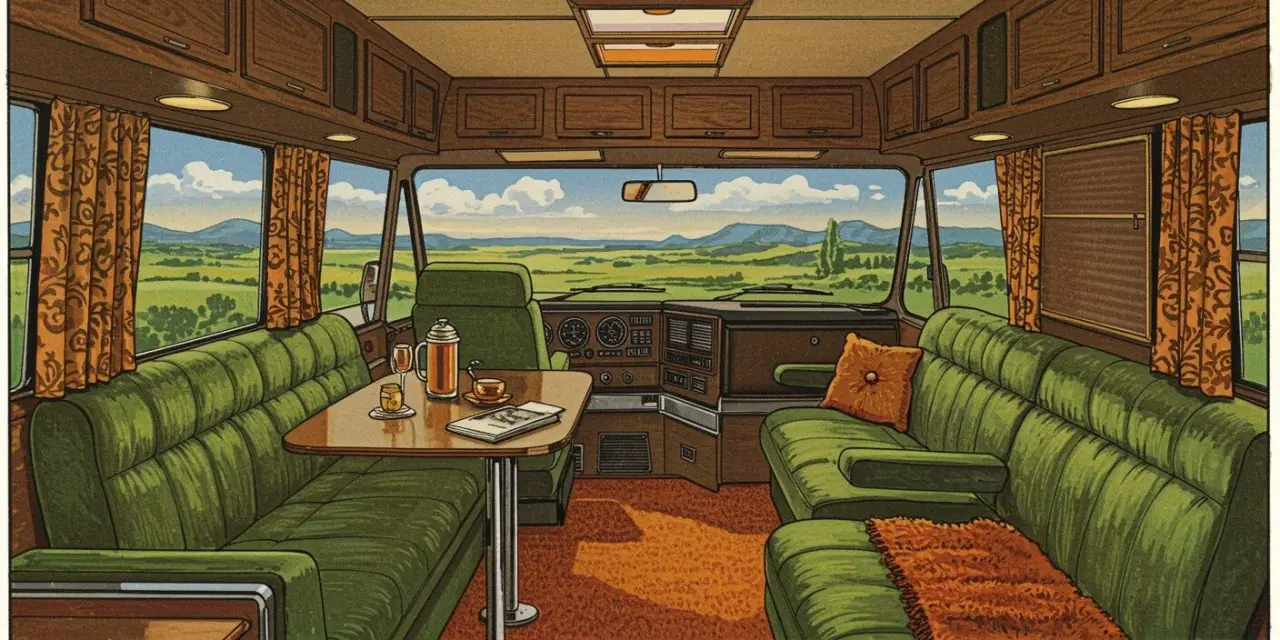Would you like to save this article?
The 1970s was a decade of innovation and forward-thinking design, especially in the recreational vehicle industry. Among the crowded field of boxy, truck-based RVs, one particular model stood out like a futuristic time traveler: the GMC Motorhome.
Built from 1973 to 1978, this revolutionary vehicle wasn’t just another camper—it was a bold statement from General Motors, America’s largest automaker. What made the GMC Motorhome special was that it was designed and manufactured entirely in-house by GM, the only time a major car company committed to producing a complete motorhome under its own engineering and design teams. With its sleek, aerodynamic profile, panoramic windows, and technology that was decades ahead of its competitors, this iconic RV continues to captivate enthusiasts even today.
Let’s explore the seven incredible features that made the GMC Motorhome a vehicle that truly belonged to the future.
1. Revolutionary Front-Wheel Drive System
The GMC Motorhome featured a front-wheel drive system borrowed from the Oldsmobile Toronado, a personal luxury car introduced by GM in 1966. This innovative drivetrain included a longitudinally mounted 455 cubic inch (7.5L) Rocket V8 engine paired with a Turbo Hydramatic 425 automatic transmission, delivering power directly to the front wheels.
This engineering decision eliminated the need for a traditional drive shaft and rear differential, allowing for a completely flat floor throughout the cabin and a lower center of gravity. The absence of a rear drivetrain made the vehicle more stable and improved handling significantly compared to traditional motorhomes.
The Numbers:
- Engine: 455 cubic inch (7.5L) Rocket V8
- Transmission: 3-speed Turbo Hydramatic 425 automatic
- Configuration: Front-wheel drive
I bet the engineer who pitched this idea got a lot of “You want to put WHAT in a motorhome?” looks in the GM boardroom. Imagine explaining to the old-school truck guys that you’re building an RV with a luxury car’s drivetrain. Bold move, GM, bold move!
2. Aircraft-Inspired Body Construction
The body of the GMC Motorhome was built using a technique more common in aircraft and high-end sports cars than recreational vehicles. The exterior featured fiberglass reinforced plastic panels bonded to an aluminum frame, creating a smooth, aerodynamic shape that stood in stark contrast to the boxy designs of traditional RVs.
This innovative construction method not only gave the motorhome its distinctive futuristic appearance but also provided significant practical benefits:
- Reduced overall weight
- Improved fuel efficiency
- Enhanced aerodynamics
- Superior durability and corrosion resistance
- Lower center of gravity for better handling
What’s truly impressive is that this construction method remains advanced even by today’s standards, with many modern premium RVs only now adopting similar lightweight composite materials.
If this RV were a person, it would be that one friend who showed up to the 1973 disco in what everyone else would be wearing in 1990. Meanwhile, other RVs were basically wooden crates on wheels. Talk about fashion-forward!
3. Unique Tandem Rear Wheel Air Suspension
While most RVs of the era used traditional leaf spring suspensions, the GMC Motorhome featured a sophisticated air suspension system for its four rear wheels. This design was adapted from GM’s city buses and provided several advantages:
- Independent swing arm suspension with airbags for the rear wheels
- Automatic load-leveling capability to maintain consistent ride height
- Significantly smoother ride quality over varying road surfaces
- Better weight distribution and stability
The six-wheel configuration (two front, four rear in tandem pairs) allowed the motorhome to maintain a smoother, more controlled ride that was often compared to a large passenger car rather than a typical motorhome.
GMC Motorhome vs. Standard 1970s RVs:
| Feature | GMC Motorhome | Standard 1970s RVs |
|---|---|---|
| Suspension | Air suspension with independent rear wheels | Leaf springs on solid axles |
| Ride Quality | Car-like smoothness | Truck-like bouncing |
| Height Adjustment | Automatic leveling | Manual stabilizers |
| Road Handling | Stable with minimal body roll | Top-heavy with significant sway |
The first time someone rode in one of these, they probably checked to make sure they were actually in an RV and not accidentally boarding a luxury cruise ship. “Wait, we’re going over bumps? Could’ve fooled me!”
4. Panoramic Windows and Low-Profile Design
The GMC Motorhome featured expansive panoramic windows that wrapped around much of the vehicle, providing:
- Unobstructed 180-degree views for drivers and passengers
- Abundant natural light throughout the interior
- A sense of spaciousness rarely found in motorhomes
- Better visibility for safer driving
Combined with its low-profile design (made possible by the absence of a rear drivetrain), the GMC Motorhome had a much lower center of gravity than conventional RVs. This not only improved handling but also gave the vehicle its distinctive sleek, futuristic appearance.
The front of the motorhome was dominated by a wide, curved windshield that provided a commanding view of the road. Side windows extended generously down the length of the vehicle, creating a bright, open interior atmosphere.
I’ve heard that passengers in traditional RVs would play a game called “guess the view” since their tiny windows showed about as much scenery as a prison cell. Meanwhile, GMC owners were basically driving around in glass observation lounges. Talk about an upgrade!
5. Dual Climate Control Systems
In an era when many RVs had minimal climate control, the GMC Motorhome came standard with a sophisticated dual air conditioning system:
- A dash-mounted automotive-style AC unit for the driver and front passenger
- A roof-mounted Coleman or Dometic unit for the rear living area
- Zoned cooling for optimal comfort in different areas
- Central heating system throughout the cabin
This advanced climate control system was decades ahead of its time, offering a level of comfort that many modern RVs still struggle to match.
Temperature Facts:
- Driver area could be maintained at comfortable driving temperature
- Living quarters could be pre-cooled while parked
- System could maintain comfortable interior even in extreme heat
- Eliminated the “hot/cold spots” common in other RVs of the era
It’s like GM designers looked at other RVs and thought, “You know what would be nice? If the driver didn’t arrive at the campsite looking like they just hiked through the Sahara while the passengers in back weren’t turning into popsicles.” Revolutionary thinking right there!
6. Modular Interior Design with Luxury Appointments
The GMC Motorhome offered an innovative modular interior design that was customizable to suit different needs and preferences. GM introduced a series of fully furnished variants under distinct package names such as Palm Beach, Eleganza, Sequoia, Canyonlands, and Glacier.
These trim packages weren’t just different names—they offered:
- Coordinated color schemes
- Premium upholstery materials
- Custom cabinetry finishes
- Matching wall treatments and decor elements
Common layouts typically included:
- Forward lounge area with convertible dinette or sofa bed
- Galley kitchen along one side
- Bathroom with toilet and shower
- Rear sleeping quarters (either twin beds or full-width double bed)
The flat floor, made possible by the front-wheel drive layout, allowed for more flexible interior arrangements and easier movement throughout the cabin.
Looking at the interior design options of the GMC Motorhome is like watching a 1970s home decor show come to life on wheels. Shag carpet? Check. Wood-grain everything? Check. Colors that would make a peacock jealous? Double check. And somehow, it all still looks amazing today!
7. Enduring Design and Community
Perhaps the most telling evidence of the GMC Motorhome’s ahead-of-its-time design is its enduring popularity. Despite production ending in 1978 after just six years, an estimated 8,000 of the original 12,921 units are still on the road today—an extraordinary survival rate for any recreational vehicle.
The GMC Motorhome has inspired a passionate community of owners and enthusiasts who continue to maintain, restore, and even modernize these vehicles:
- Dedicated clubs such as GMC Motorhomes International and GMC Western States
- Regular rallies and events across the country
- Specialized parts suppliers and restoration services
- Modern upgrades including solar power, lithium batteries, and digital systems
Many owners have updated their motorhomes with contemporary technology while preserving the iconic design and engineering that made them special.
GMC Motorhome Legacy:
- Only ~13,000 units produced (1973-1978)
- Estimated 60-70% still operational today
- Strong resale values (often higher than original price)
- Featured in movies, TV shows, and popular culture
- Recognized as one of the most innovative RVs ever built
If vehicles could apply for time travel permits, the GMC Motorhome would be first in line. It’s the RV equivalent of finding out your grandparent was a rock star in their youth—surprisingly cool, impossibly hip, and somehow still more stylish than most of what’s on the road today. No wonder these things are collector’s items!
Conclusion
The 1970s GMC Motorhome stands as a testament to what happens when a major automotive manufacturer applies its full engineering and design resources to reimagine what a recreational vehicle could be. Its front-wheel drive system, aircraft-inspired construction, air suspension, panoramic windows, climate control, modular interior, and enduring community support all contributed to creating an RV that was truly 30 years ahead of its time.
Although production lasted only six years, the impact of the GMC Motorhome continues to resonate throughout the RV industry. Many of its innovations have become standard features in modern motorhomes, while others—such as its low profile and car-like handling—remain aspirational even today.
For RV enthusiasts, the GMC Motorhome remains the gold standard of what’s possible when innovation, style, and practicality come together on six wheels. It’s not just a piece of RV history—it’s a rolling vision of the future that happened to arrive in 1973.
SOURCES:
- GMC Motorhome International – Historical Documentation and Owner Resources
- Family Motor Coach Association – GMC Motorhome Archives





